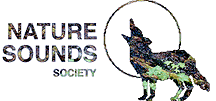NSS Home Page  Nature Sounds Newsletter Nature Sounds Newsletter  Winter 1994 Winter 1994  Ambisonics: The Art of "Being There" Ambisonics: The Art of "Being There"
|

|
Ambisonics: The Art of "Being There"
by Jeffrey Silberman SurroundWorks (415) 380-8273 Many years ago, Wallace C. Sabin, the famous acoustician, wrote about man's primal need to be enveloped by sound: "Since ancient times, man has been fascinated by the echoes and reverberations of cathedrals and caves." As a means to reproduce a soundscape, stereo is an improvement over mono, but two speakers alone- regardless of quality- cannot convey a realistic sense of envelopment. Within a confined space, sound arrives at a listener from all directions- front, behind, above and below, sound which is much more realistic than stereo. Happily, plans are well under way by Dolby, Digital Theater Systems and Sony to bring to the home market their respective discrete multichannel surround sound theater systems. Home theater, as we know, is driving the consumer audio marketplace, and owners of such systems will desire to take advantage of the multiple loudspeakers for audio-only programs. Indeed, Pioneer intends to provide 5.1 discrete full-bandwidth digital channels on a laserdisc by means of compressed audio under the trademark "LaserDigital." Surround sound is also feasible on a CD. With advent of HDTV’s quintaphonic sound standard, there is no doubt that the future is promising for surround sound. THE A,B,C'S OF W,X,Y AND Z Despite its invention nearly 20-years ago, ambisonics has remained rather obscure to this day due to the fact that decoding processors have not been readily available. Moreover, at least 3 production sound channels are required to sample a soundfield ambisonically, thus necessitating a multitrack recorder. A specially designed microphone called the & #147Soundfield” is generally employed. The Soundfield contains a tetrahedral array of 4 subcardioid condenser capsules whose respective outputs are added and subtracted to produce the following acoustically equivalent microphone signals: W, X, Y and Z, where W is an omni pattern, X is a forward-facing figure-eight pattern, Y is a side-facing figure-eight pattern and Z is an upward-facing figure-eight pattern. Both incidents of sound, pressure and direction at a single point in space are sampled. These so-called "B-Format" recordings can be matrixed into a 2-channel & #147UHJ” ambisonic format for release on standard CD’s (Nimbus Records has been doing so for many years). Alternatively, any coincident stereo recording technique can be derived in post-production from the captured 360 degree spherical soundfield. However, UHJ encodings are superior to stereo derivations and nearly as realistic as the non-matrixed B-Format source. Currently, Onkyo markets and Meridian Audio plans to market all-purpose surround sound decoders with UHJ ambisonic chips. For professional applications, Audio-Design of England produces the only B-Format decoder as well as an entire line of B-Format processing equipment. AMBISONICS vs. STEREO All recording techniques are a compromise. Still unlike stereo which recreates merely the horizontal soundfield subtended by a pair of loudspeakers (normally 60 degrees), ambisonics reproduces the full 360 degree horizontal soundfield by means of no less than 4 preferably identical loudspeakers positioned in a symmetrical layout, e.g. , a rectangle, octagon, etc. (The presentation of height, that is, the full spherical soundfield, necessitates a similar layout above the listener). Ambisonics must not be equated with quad which simply comprised stereo times two- 4 speakers in all. Unlike quad, ambisonic decoders take into account any number of loudspeakers greater than four and their angular layout around the listener. Since real sources are better than phantom ones, the more loudspeakers the better. In this respect, ambisonics differs from all other surround sound systems which are designed to employ a fixed number of loudspeakers (generally no more than six). Moreover, do not be tempted to believe that synthesized reverberation delivered to the rear speakers is tantamount to ambisonic playback. While it may enhance stereo playback, a synthetic soundfield is not an accurate representation of the original acoustic. The raison d'etre of ambisonics is 360 degree localization. A soundfield microphone, for instance, placed between performers and audience accurately reproduces the performance before, the audience behind and the ambiance around you. Not so with stereo where the audience and ambiance emanate from the same loudspeakers as the music. Not only is this spatial presentation inaccurate, but the audience may mask the music and the delayed ambiance may interfere with the direct sound causing comb-filtering. Ambisonics preserves the original locations of music, ambiance, and audience as they originally existed is a three-dimensional space, and in so doing, the musical timbre is not compromised. In short, ambisonics does fewer things wrong than does stereo. THE ILLUSION CONCLUSION Transporting the soundfield of a performance space to a listening space is the ultimate goal. Until we invent a time machine, however, an illusion of "being there" will have to suffice. Sitting within our listening space, we would like to believe that we are at the performance. While my practice (i.e., with a minimum of 4 speakers) has yet to achieve this ideal, I am much more able- than with stereo- to suspend my disbelief in the illusion. To this end, I insist upon listening in utter darkness so as to eliminate all contradictory visual evidence to the aural experience. I welcome one and all to audition ambisonics in my studio since, to my knowledge, mine is the only professional ambisonic system in the US. Those interested in networking with ambisonic devotees can contact the Ambisonic and B-Format Users Group (ABUG) at 51 Hillside Avenue, Plymouth, Devon PL4 6PS, Great Britain. |

|
This site and its contents copyright © 1996-2003 The Nature Sounds Society. About this web site |

|
